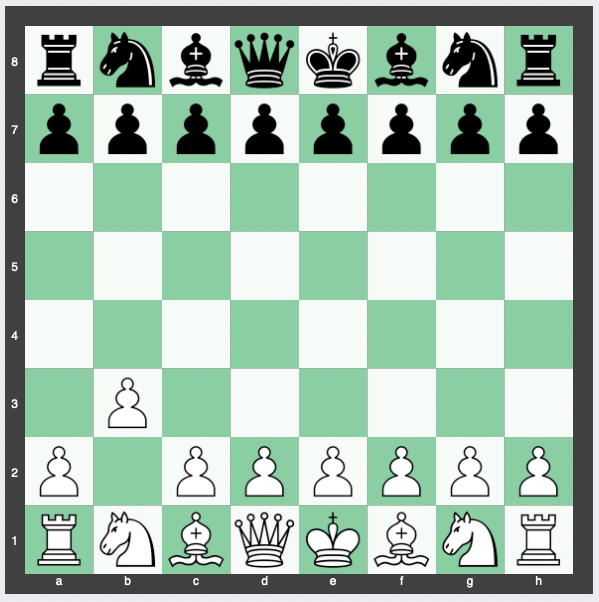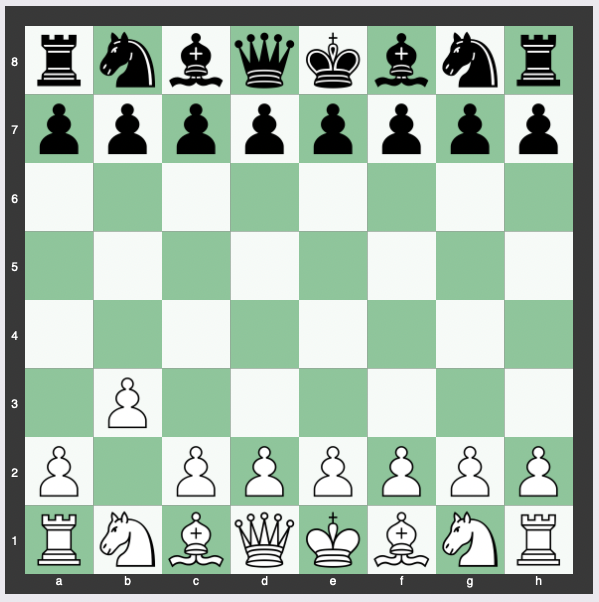Larsen’s Opening, also known as the Nimzowitsch-Larsen Attack or Nimzo-Larsen Attack, named most prominently after the Danish Grandmaster Bent Larsen, is a chess opening that begins with the move 1.b3.
Notoriously unorthodox and offbeat, it diverges from traditional opening principles to offer players a unique approach to the game’s early stages.
We look into the dynamics of Larsen’s Opening, its move order, theory, strategy, purpose, variations, history, and its suitability for beginners and intermediates.
It also evaluates its frequency of use at the grandmaster level.
Move Order of Larsen’s Opening
The move order of Larsen’s Opening is straightforward, beginning with 1.b3.

This initial move opens a pathway for the queen’s bishop (the one on c1) to develop along the long diagonal from a1 to h8.
Typically, the bishop would be fianchettoed at b2, but the specifics of subsequent moves can vary based on how Black responds.
Theory, Strategy and Purpose of 1.b3
Larsen’s Opening embraces the hypermodern chess philosophy, where control of the center is pursued indirectly.
By fianchettoing the bishop, White aims to control the center from a distance instead of occupying it with pawns directly.
One of the main strategic purposes of this opening is to catch Black off-guard, due to the non-standard starting move.
Its overall purpose is to disrupt traditional opening theory and to sidestep early memorized sequences of moves, leading to complex and less explored positions on the board.
Variations of Larsen’s Opening
There are numerous variations in Larsen’s Opening depending on how Black responds.
The most common responses include 1…e5, which allows Black to occupy the center, and 1…Nf6, which aims to counter-attack and potentially prepare for a double fianchetto setup.
Another frequently played line is 1…d5, aiming for a symmetrical setup.
The Nimzo-Larsen attack (1.b3 and 2.Bb2 followed by 3.e3 or 3.Nf3) is another major branch of this opening, incorporating ideas from Aron Nimzowitsch’s hypermodern strategies.
Evaluation of 1.b3
1.b3 is generally evaluated around -0.10 for white.
We rate it as the #10 of 20 for the best opening moves.
Theory & Continuation Lines of Larsen’s Opening – 1.b3
Some theory and continuation lines and variations following 1.b3 include:
1… e5 2. c4 Nf6 3. Bb2 Nc6 4. e3 d5 5. cxd5
1… e5 2. Bb2 Nc6 3. e3 Nf6 4. Bb5 e4 5. Nc3 a6 6. Bxc6 dxc6 7. d3 Bf5 8. f3 exd3 9. e4 Be6 10. Qxd3
1… e5 2. Bb2 Nc6 3. e3 Nf6 4. Nf3 e4 5. Nd4 Nxd4 6. Bxd4 d5 7. c4 c5 8. Bxf6 Qxf6 9. Nc3 d4 10. Nxe4 Qg6 11. Qc2
1… e5 2. Bb2 Nc6 3. e3 Nf6 4. c4 d5 5. cxd5 Nxd5 6. a3 Bd6 7. Nc3 Nxc3 8. Bxc3 Qe7 9. b4 Bf5 10. Ne2 O-O-O 11. Ng3
1… e5 2. Bb2 Nc6 3. e3 Nf6 4. Nf3 e4 5. Nd4 Bc5 6. Nxc6 dxc6 7. d4 exd3 8. cxd3 Qe7 9. Be2 Bf5 10. O-O
1… e5 2. Bb2 Nc6 3. e3 d5 4. Bb5 Bd6 5. Nf3 Qe7 6. c4 Nf6 7. c5 Bxc5 8. Nxe5 O-O 9. Nxc6 bxc6 10. Bd3 Rd8 11. O-O h5 12. Qc2 d4
The most common reply or counter to 1.b3 is 1… e5, with white following up by fianchetto’ing its dark-square bishop.
Magnus Carlsen Nimzo-Larsen Variation 1.b3
History of 1.b3
Larsen’s Opening is named after the Danish Grandmaster Bent Larsen, who popularized it during the 1960s and 1970s.
Despite breaking conventional opening principles, Larsen used this opening with great success in his games against top players of his era.
However, it is worth noting that this opening was played even before Larsen’s time, though it was not as recognized or popular.
Over the years, this opening has been employed by other top players as a surprise weapon, furthering its evolution.
Whether 1.b3 Is Good for Beginners or Intermediates
While Larsen’s Opening might not strictly adhere to traditional opening principles often taught to beginners, it can still be a valuable opening for learning.
The unorthodox nature of 1.b3 can encourage beginners and intermediates to think more critically about their moves and strategies, rather than relying solely on memorized lines.
This opening is a great tool to develop a deeper understanding of the hypermodern principles.
However, they should be aware of the challenges it may pose, as it can lead to complex positions that require a good understanding of positional play and pawn structure.
How Often 1.b3 Is Played at the Grandmaster Level
Although Larsen’s Opening is not a mainstream choice at the grandmaster level, it still sees occasional use as a surprise weapon.
Its unconventional nature can unsettle opponents and lead to less familiar territory.
Grandmasters like Richard Rapport and Hikaru Nakamura have used it in recent years, underlining its ongoing relevance in top-tier play.
However, due to its unorthodox approach and the risk it entails, it’s less frequently seen compared to other more conventional openings like the e4 or d4 or the Spanish Game.
FAQs – Larsen’s Opening: 1.b3
1. What is Larsen’s Opening – 1.b3?
Larsen’s Opening (1.b3) is a non-traditional chess opening named after the Danish Grandmaster Bent Larsen.
It signifies the move 1.b3 for white, aiming to control the central e5 square using a fianchetto setup of the Queen’s Bishop.
Though it’s not as commonly used as other openings like 1.e4 or 1.d4, it’s highly flexible and can lead to unorthodox game positions, thereby giving chances for both sides to make strategic and tactical mistakes.
2. How does Larsen’s Opening differ from more common openings?
More traditional chess openings like 1.e4 and 1.d4 directly control the center from the first move, and aim to develop the kingside pieces quickly.
In contrast, Larsen’s Opening 1.b3 is a hypermodern opening that takes a more indirect approach to control the center, by deploying the bishop to b2 to put pressure on the e5 square.
3. Why would a player choose Larsen’s Opening over a more traditional opening?
The primary advantage of choosing Larsen’s Opening is its flexibility and potential for surprise. It may take an opponent out of their preparation and force them into an unfamiliar type of game.
Also, the positions from Larsen’s Opening can be highly strategic and complex, giving opportunities for players who are proficient in it to outmaneuver their opponents.
4. What are the main line and key variations in Larsen’s Opening?
After 1.b3, the game can branch out into various lines, but some of the more frequently seen responses from black include 1…e5, 1…d5, 1…Nf6, and 1…c5.
The main line often continues with 1…e5 2.Bb2 Nc6, where white will aim to undermine black’s central control.
In the 1…d5 variation, a common response is 2.Bb2, aiming for quick control over the center.
5. How can Black respond effectively to Larsen’s Opening?
One way for Black to respond to Larsen’s Opening is by quickly occupying the center with pawns (like 1…d5 or 1…e5).
Black can also develop knights to f6 and c6, which gives both control over the center and good development.
It’s also possible to fianchetto the Queen’s Bishop as a direct counter to White’s setup.
6. Are there any famous games played with Larsen’s Opening?
Yes, several famous games have been played with Larsen’s Opening, many of them by Bent Larsen himself.
A notable example is the game between Bent Larsen and Boris Spassky in 1970, where despite a hard-fought battle, Larsen lost to Spassky.
7. Are there any particular weaknesses to Larsen’s Opening?
Larsen’s Opening can lead to a slower development of the knight on b1 and the lack of central control in the early phase can provide opportunities for the opponent to seize the initiative.
Also, if not handled carefully, the bishop on b2 may become a target and can be trapped.
8. What types of mid-game positions does Larsen’s Opening usually lead to?
Typically, Larsen’s Opening leads to strategic, positional games rather than highly tactical ones.
The opening generally results in asymmetrical pawn structures that avoid early simplification, leading to a rich middle game.
The fianchettoed bishop often exerts long-term pressure on the center and can contribute to attacks on the king.
9. How do I practice Larsen’s Opening effectively?
Practicing Larsen’s Opening involves playing it in games, studying classic games that have used this opening, and using chess software to analyze different positions and understand the nuances.
Reviewing these games and positions with a chess coach or stronger player can be very helpful.
10. What rating level should I be before I start using Larsen’s Opening?
While there is no hard and fast rule for this, Larsen’s Opening is typically more popular with intermediate to advanced players who are comfortable with handling the strategic and positional challenges that this opening presents.
However, even beginners can experiment with it to broaden their understanding of different opening principles.
Conclusion
In the diverse universe of chess openings, Larsen’s Opening stands out as a distinct and intriguing option.
By breaking away from the norms of traditional opening play, it challenges players to rethink their strategies and adapt to a less familiar landscape.
Although it may not be the first choice for grandmasters or beginners, its hypermodern charm, the surprise element, and the rich complexity it offers ensure its enduring appeal to those seeking a path less traveled in the game of chess.


